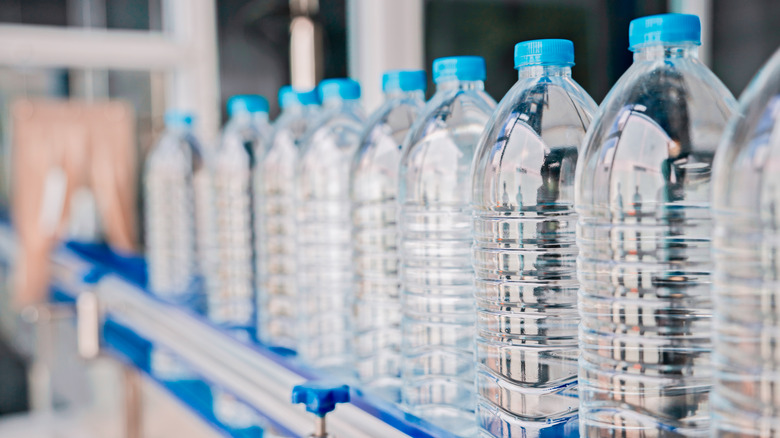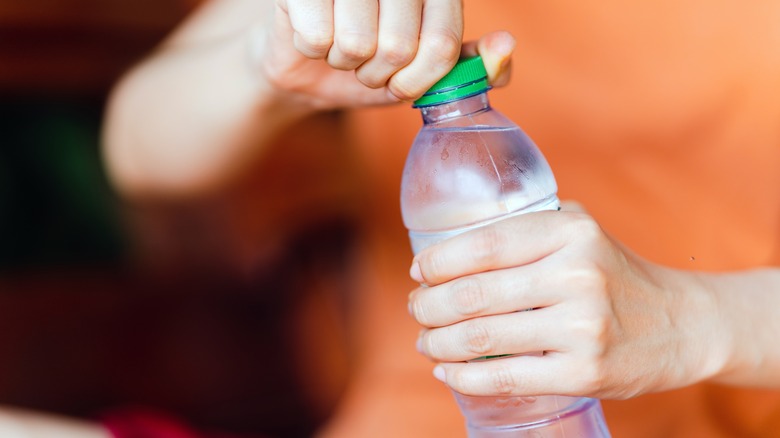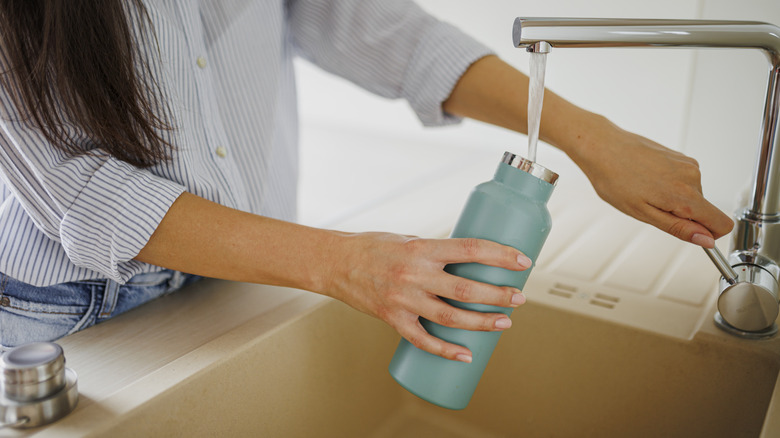What You Need To Know About Microplastics In Bottled Water
It's common knowledge at this point that plastic doesn't break down the way paper products do. During its tenure in a landfill, rather than decompose, plastic breaks down into smaller and smaller pieces, called microplastics. Worse still, plastic doesn't always reach landfills, often ending up in the ocean or other terrestrial ecosystems, atomizing there. An estimated 30 million tons of plastic are dumped worldwide every single year, and according to a new study from researchers with Columbia University's Mailman School of Public Health, some portion of it is likely to end up inside our bodies.
The study found that bottled water contains anywhere from 10 to 100 times more microplastics than previously thought (yikes). Published Monday in the "Proceedings of the National Academy of Sciences," it examined three undisclosed brands of bottled water using Stimulated Raman Scattering (SRS) microscopy, which uses a pair of lasers to analyze the sample's contents, and the findings were troubling.
Just one liter of bottled water contained an average of 240,000 detectable plastic fragments in each liter, 10% of which were microplastics (5mm to 1 micrometer) and 90% of which were smaller nanoplastics (fragments smaller than a micrometer). A previous estimate based on a 2018 study arrived at a number that was closer to 325 microplastic fragments per liter, but it turns out that figure was off by literally hundreds of thousands.
What are microplastics, exactly?
As Sherri Mason, the Director of Sustainability at Penn State explained to CNN, "People don't think of plastics as shedding but they do. In almost the same way we're constantly shedding skin cells, plastics are constantly shedding little bits that break off, such as when you open that plastic container for your store-bought salad or a cheese that's wrapped in plastic."
Microplastics can pass into your blood, brain, and cells, and they have already been found in human blood, excrement, lungs, and placenta. They've been found in soil, drinking water, food, and polar ice. Nanoplastics may be 1,000th the average width of a human hair, but if they sound like the smaller of two evils, think again. Due to their tiny size, nanoplastics are easier for doctors and biomedical researchers to misidentify as part of a person's cellular makeup, able to pass "through the intestines and lungs directly into the bloodstream and travel from there to organs including the heart and brain," explains the Columbia University study.
So ... can they hurt you? The short answer, for now, is that scientists aren't really sure. Beyond their presence in human tissue, other effects remain largely unknown, and scientists are exploring the potential toxicity of microplastics, but it's a fairly new topic of research. Still, the prospect of having tiny bits of plastic inside of you is unappealing, to say the least, and existing hypotheses about its potential effects aren't reassuring.
Should consumers be worried?
Researchers are actively trying to develop a more thorough understanding of how these fragments of foreign matter affect human, animal, and ecosystem health. Experts have thus far determined that nanoplastics can invade individual cells in major organs, potentially interrupting crucial bodily processes and introducing foreign chemicals into the body. According to a piece in Frontiers in Endocrinology, these include but are not limited to flame retardants, bisphenols, phthalates, and heavy metals. Disturbingly, it's yet unknown how or if microplastics are expelled from the body once they enter.
The International Bottled Water Association released an official statement on January 8 in response to the findings of the university study, and insisted that "more research needs to be done to develop standardized methods for measuring and quantifying nanoplastics in our environment," and that until conclusive data is found, "media reports about these particles in drinking water do nothing more than unnecessarily scare consumers."
While this might sound like a deflection, it's not inaccurate to say we don't yet know whether or to what extent nanoplastics are harmful to human health. As Rutgers toxicologist and co-author of the study, Phoebe Stapleton told The Associated Press, "We don't know if it's dangerous or how dangerous. We do know that they are getting into the tissues (of mammals, including people) ... and the current research is looking at what they're doing in the cells."
How to stay safe while answers emerge
Has the microplastics issue gotten dramatically worse over the past few years? Or have detection technologies just improved? The truth is probably some combination of both. Until more quantitative evidence is produced in this rapidly growing field, researchers hope to develop a better understanding of how much plastic people are ingesting, and what the ramifications of that consumption might be. In the meantime, there are a few measures consumers can take to keep themselves safe.
To reduce your everyday consumption of microplastics, reduce exposure to plastic products as much as possible. Opt for reusable items, avoid single-use plastics, especially in cooking applications, as heating plastics can leach BPA and phthalates into your food. For now, scientists generally agree that there are fewer microplastics in tap water than in bottled water. Cautious consumers should fill up their reusable water bottles at home — ideally non-plastic ones, like those made of glass, stainless steel, or aluminum.



